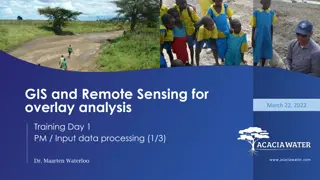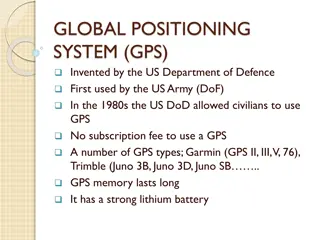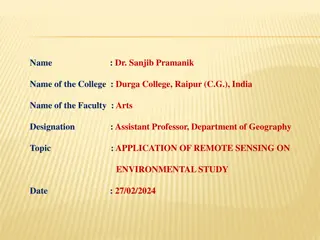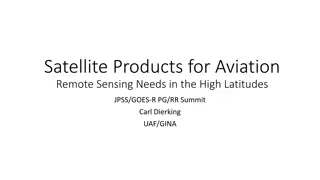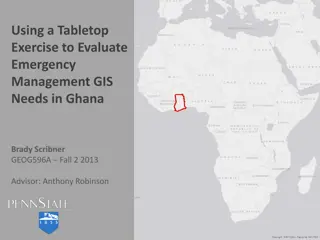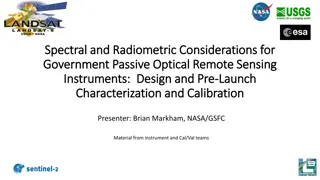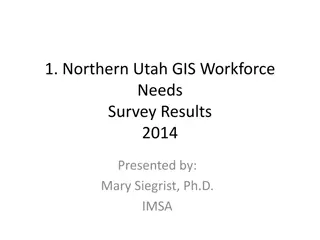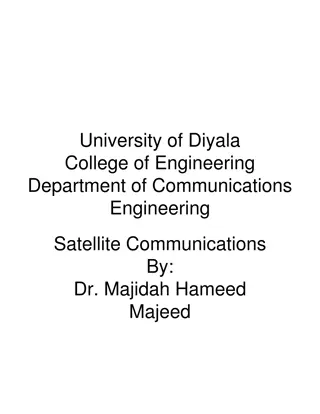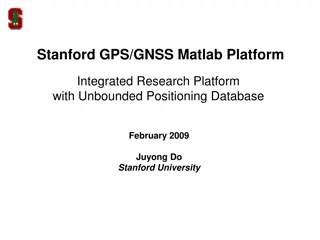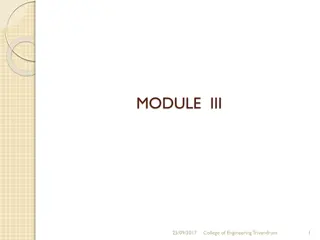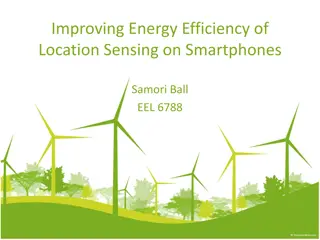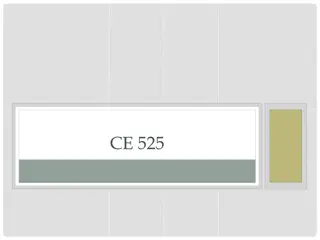Understanding GPS, GIS, and Remote Sensing: A Comprehensive Overview
Global Positioning System (GPS) is a satellite-based radio positioning system operated by the U.S. Department of Defense. It offers high positioning accuracies, velocity determination, and time accuracy worldwide. The system comprises three segments: Space Segment, Control Segment, and User Segment. The Space Segment involves satellites broadcasting signals for position determination, while the Control Segment monitors satellite health and maintains accurate time. The system is free to use and available 24/7 in all weather conditions.
Download Presentation

Please find below an Image/Link to download the presentation.
The content on the website is provided AS IS for your information and personal use only. It may not be sold, licensed, or shared on other websites without obtaining consent from the author. Download presentation by click this link. If you encounter any issues during the download, it is possible that the publisher has removed the file from their server.
E N D
Presentation Transcript
GPS,GIS AND RS GPS,GIS AND RS
INTRODUCTION TO GPS Global Positioning System (GPS) is a satellite Global Positioning System (GPS) is a satellite- -based radio timetransfer timetransfer based radio- -positioning and positioning and system designed, financed, deployed, and operated by the U.S. Department of system designed, financed, deployed, and operated by the U.S. Department of Defense Defense. .
WHAT ATTRACTS US TO GPS? The relatively high positioning accuracies, from tens of metres down to the millimetre level. The capability of determining velocity and time, to an accuracy commensurate with position. The signals are available to users anywhere on the globe: in the air, on the ground, or at sea. Its is a positioning system with no user charges, that simply requires the use of relatively low cost hardware. It is an all-weather system, available 24 hours a day. The position information is in three dimensions, that is, vertical as well as horizontal information is provided. .
Segments of GPS Segments of GPS 1.The Space Segment: comprising the satellites and the transmitted signals. 1.The Space Segment 2. The Control Segment: the ground facilities carrying out the task of satellite 2. The Control Segment tracking, orbit computations, telemetry and supervision necessary for the daily control of the space segment. 3.The User Segment: the entire spectrum of applications equipment and 3.The User Segment computational techniques that are available to the users.
THE SPACE SEGMENT The Space Segment consists of the constellation of spacecraft and the signals broadcast by them which allow users to determine position, velocity and time. The basic functions of the satellites are to: 1.Receive and store data transmitted by the Control Segment stations. 2. Maintain accurate time by means of several on-board atomic clocks.
THE CONTROL SEGMENT The Control Segment consists of facilities necessary for satellite health monitoring, telemetry, tracking, command and control, satellite orbit and clock data computations, and data up linking. There are five ground facility stations: Hawaii, Colorado Springs, Ascension Island, are There are five ground facility stations: Hawaii, Colorado Springs, Ascension Island, are owned and operated by the U.S. Department of Defence . owned and operated by the U.S. Department of Defence . Functions; Functions; 1.The operational control segment(OCS) tracks and maintains the satellite in space. 1.The operational control segment(OCS) tracks and maintains the satellite in space. 2.It updates the satellite clock corrections and other parameters essential for 2.It updates the satellite clock corrections and other parameters essential for determination of use position, velocity and time. determination of use position, velocity and time.
The User Segment This provides This provides 1.Navigation 1.Navigation 2.Timing 2.Timing The User Segment
THE SATELLITE CONSTELLITION THE SATELLITE CONSTELLITION At an altitude of approximately 20,200km, a constellation of 24 satellites functioning This satellite constellition is sufficient to ensure that there will always be at least four satellites visible, at all unobstructed sites on the globe. Typically there are 6 to 10 satellites visible most of the day. As the GPS satellites are in nearly circular orbits, at an altitude of approximately 20,200km above the Earth, this has a number of consequences: Their orbital period is approximately 11hrs 58mins, so that each satellite makes two revolutions in one sidereal day (the period taken for the earth to complete one rotation about its axis with respect to the stars). At the end of a sidereal day (23hrs 56mins in length) the satellites are again over the same position on earth. The orbit groundtrack approximately repeats each day, except that there is a very small drift of the orbital plane to the west which is arrested by periodic manoeuvres.
Satellites are deployed in six orbital planes at 60 degree intervals about the equator, with each containing four satellites. The satellites can be moved round their orbits if it becomes necessary to "cover" for a failed satellite. The orbital planes are inclined at an angle of 55 degree to the equatorial plane. As the satellites are at an altitude of more than three times the earth's radius, a particular satellite may be above an observer's horizon for many hours, perhaps 6-7 hours or more in the one pass
Positioning using GPS. Positioning using GPS. VIDEO
Applications of GPS Applications of GPS (1)Navigation (2)Surveying (1)Navigation (2)Surveying
Surveying Surveying GPS can be used for surveying in the process of locating points on the surface of the GPS can be used for surveying in the process of locating points on the surface of the earth. earth. GPS can be used in base line measurements for geodetic surveying, stalking out and GPS can be used in base line measurements for geodetic surveying, stalking out and many other forms of survey many other forms of survey GPS is very GPS is very usful usful for layout works for locating for layout works for locating boundries boundries. . Overall this technique is faster & accurate Overall this technique is faster & accurate
Remote sensing is the acquisition of information about an object or phenomenon without making physical contact with the object. In modern usage, the term generally refers to the use of aerial sensor technologies to detect and classify objects on Earth (both on the surface, and in the atmosphere and oceans) by means of propagated signals (e.g. electromagnetic radiation emitted from aircraft or satellites)
There are two main types of remote sensing: 1.Active remote sensing 2.Active remote sensing
PASSIVE REMOTE SENSING Passive sensors detect natural radiation that is Passive sensors detect natural radiation that is emitted or reflected by the object or emitted or reflected by the object or surrounding areas. surrounding areas. Reflected Reflected sunlight sunlight is the most common source of is the most common source of radiation measured by passive sensors. radiation measured by passive sensors. Examples of passive remote sensors include Examples of passive remote sensors include film film photography photography, , infrared infrared, , charge devices devices, and radiometers. Active collection, on the , and radiometers. Active collection, on the other hand, emits energy in order to scan objects other hand, emits energy in order to scan objects charge- -coupled coupled
The sensor emits radiation which is directed toward the target to be investigated. The sensor emits radiation which is directed toward the target to be investigated. The radiation reflected from that target is detected and measured by the sensor. The radiation reflected from that target is detected and measured by the sensor. Advantages for active sensors include the ability to obtain measurements Advantages for active sensors include the ability to obtain measurements anytime, regardless of the time of day or season. Active sensors can be used for anytime, regardless of the time of day or season. Active sensors can be used for examining wavelengths that are not sufficiently provided by the sun, such as examining wavelengths that are not sufficiently provided by the sun, such as microwaves, or to better control the way a target is illuminated microwaves, or to better control the way a target is illuminated
WHAT? WHAT? GIS or GIS or geographic information system geographic information system (GIS) is a system designed to capture, store, manipulate, store, manipulate, analyze analyze, manage, and present all types of , manage, and present all types of geographical data (GIS) is a system designed to capture, o geographical data. . In the simplest terms, GIS is the merging of In the simplest terms, GIS is the merging of cartography and and computer science computer science technology. technology. cartography, , statistical analysis statistical analysis, , o
Modern GIS technologies use digital information, for which various digitized data creation methods are used. The most common method of data creation is digitization, where a hard copy map or survey plan is transferred into a digital medium through the use of a CAD program, and geo-referencing capabilities APPLICATIONS APPLICATIONS GIS is a relatively broad term, which can refer to a number of technologies and processes, GIS is a relatively broad term, which can refer to a number of technologies and processes, so it is attached to many operations; in engineering, planning, management, so it is attached to many operations; in engineering, planning, management, transport/logistics and analysis. transport/logistics and analysis.











